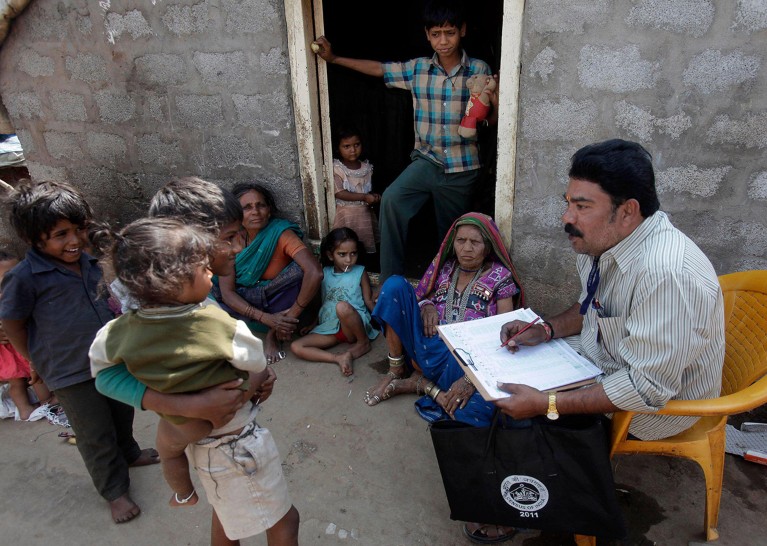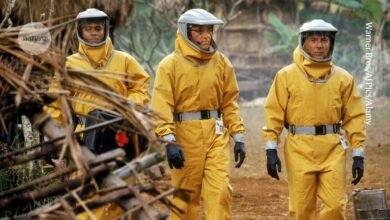

A census worker records details from women and children in Hyderabad, India during the last census in 2011.Credit: Mahesh Kumar A./AP via Alamy
Today, Hauz Khas is a chic neighbourhood in southern Delhi that is popular with wealthy urbanites. But parts of the area were classified as rural in 2011, when India’s last census was conducted. Researchers say that delays in conducting the latest national census, which was postponed because of the COVID-19 pandemic in 2021 and hasn’t been rescheduled, mean many important data sets are out of date. Without an updated census, scientists say their analyses on everything from population ageing to urban migration have become unreliable.
“Getting the census done is of the highest importance now, otherwise all our survey data are going to be questionable,” says Pronab Sen, chair of the Standing Committee on Statistics, which advises the government on its statistical surveys, based in Delhi.
The census is a trove of information about the Indian population down to the level of individual households. Governments use the data to plan and allocate resources, from vaccines to schools to grain rations. It is also a source of validation for many other surveys and analyses on economic and health trends.
“If the census doesn’t happen, then it will fundamentally harm Indian social sciences and our ability to understand Indian society,” says Aashish Gupta, a demographer at the University of Oxford, UK.
A herculean task
Undertaking a census for 1.4 billion people is a herculean task. Before it starts, there is a housing census, in which people trained to conduct the census, known as enumerators, mark every household on a map. They collect details about the type of each residence and the materials it is made of.
The house listing lays the groundwork for the population census, in which enumerators visit every household and collect details including each member’s age, education level and whether they belong to a marginalized group. They also record details about amenities in the area, such as drinking water supply and electrification. To complete the 2011 census, some 2.7 million enumerators conducted face-to-face interviews with people in 240 million households over the course of several weeks.
The data are then collated and published a few years later. The 2021 census was set to be the first to replace paper-based forms with a mobile app, potentially speeding up the process. But in September 2020, the government postponed the census because of the COVID-19 pandemic, and it has still not set a new date. “There has been sufficient time for the census to have happened,” says Gupta.
Earlier this year, the Office of the Registrar General and Census Commissioner in Delhi, which oversees the census, extended the deadline for freezing administrative boundaries, which has to happen before the census can take place. The extension was supposed to end following the national election from April to June.
Nature’s news team contacted the Office of the Registrar General and Census Commissioner for comment on why the census has not taken place, but received no response.
Unreliable analyses
Researchers say that they can make reliable projections of national trends without up-to-date census data, but estimates become less reliable at the regional, state and local levels. “We have a fair idea as to how many people there are in India, but we have no idea where they are,” says Sen.
Census data also inform the sampling strategy for more detailed and regular government surveys on births and deaths, as well as economic indicators, from unemployment to poverty to consumption, and health metrics, from fertility to child mortality to anaemia. Without updated census data, those surveys will not be representative of the population, introducing biases, say researchers. For example, areas where the population has grown will be underrepresented and areas where the population has declined will be overrepresented, says Gupta.
“India is a heavily survey-dependent country,” because of its poor quality administrative data systems, says demographer K S James, a visiting scholar at Tulane University in New Orleans, and former director of the International Institute for Population Sciences in Mumbai, India, which conducts the country’s national family health survey.
The quality of these surveys, which rely on census data, is crucial to understanding whether the country has progressed on various indicators — for instance, whether education and health-care policies have bridged the gap for marginalized communities, or reduced mortality rates in young girls, which studies have found to be higher than in young boys. “It’s so frustrating,” says Reetika Khera, a development economist at the Indian Institute of Technology Delhi (IIT Delhi). “Have we made progress in the past ten years?”
Researchers are finding it especially difficult to study trends in fertility rates and internal migration, because there has been so much change in Indian society during the past decade. Since 2011, there has been rapid rural-to-urban migration, as well as a mass return of urban migrants to rural areas during the pandemic. “It’s hard to say what proportion of the Indian population is living in urban areas right now,” says Khera. She estimates that the use of outdated census data means that more than 100 million people in rural areas are excluded from government food subsidies.
Researchers also use the census to ensure their own smaller surveys are representative of the larger population. “We use comparisons with the census to sort of validate our work,” says Sonalde Desai, a demographer at the University of Maryland in College Park.
Alternative data
Some research groups have looked for alternatives for their surveys. The electoral roll, published by the Election Commission of India, is updated at least every five years ahead of a state or national election. “It is actually a pretty good sample frame in the absence of the census,” in rural areas, says Krishanu Chakraborty, a public-policy researcher and PhD student at the IIT Delhi. But it is limited to identifying households, not individuals, he says.
Chakraborty is also assessing techniques that rely on satellite maps to tally buildings and other geospatial information in a given area and determine the size and density of a population. But without updated census data, it is difficult to confirm the accuracy of those data sets.
Source link




